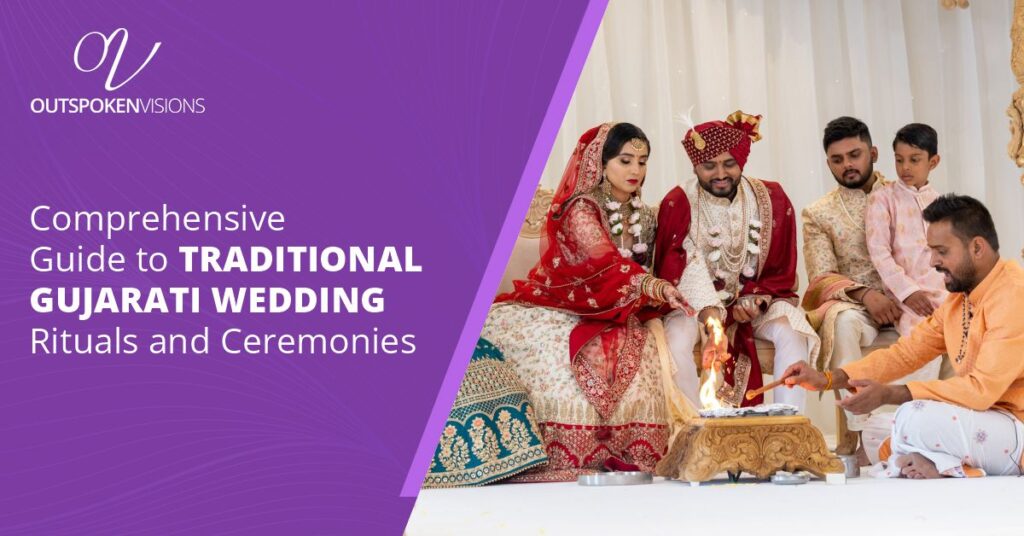Lets make it easy for you that what are the Traditional Gujarati Wedding Rituals!
Gujarat is a land bursting with colors and rich traditions! The warmth of Gujarati people, their delectable vegetarian cuisine, and the exquisite art of bandhani and patola weave blend to create a beautiful cultural experience that is best seen in a traditional Gujarati wedding. For Gujaratis, these weddings are not mere events, but rather grand celebrations filled with joy, vibrant customs, and heartfelt rituals. Held over 3-4 days, every moment is significant, brimming with festivities and joy. In this blog, we will discuss every single Gujarati wedding ritual step by step. Whether you are planning your own wedding and seeking inspiration or you have been invited to a Gujarati wedding and are curious about what to expect, this blog is for you.
Chandlo Matlii
The “Chandlo Maati” ceremony marks the start of many Gujarati customs and traditions. The bride’s father, along with four other men from the family, visits the groom’s house with a steel utensil called a “Matli” filled with sweets and gifts. The bride’s father applies a red vermillion dot the “Chandlo” on the groom’s forehead, symbolizing his acceptance into the family. Wedding dates are also finalized in this joyous event, marking the start of wedding celebrations.
Gol Dhana or Sagai
Next up is the charming Gol Dhana Ceremony, which is a traditional Gujarati wedding version of an engagement. Gol Dhana means coriander seeds and jaggery, which are distributed in the form of sweets among guests. The bride and her family visit the groom’s home, bringing many sweets and gifts. Rings are exchanged and the couple seeks blessings from five married women for a happy marriage. Gol Dhana, rich with love and tradition, is followed by Ganesh Sthapana, Grah Shanti, and a delicious traditional feast.
Lagan Lakhvanu (kankotri)
The Kankotri ceremony marks another Gujarati wedding ritual in which the first official wedding invitation is offered to God to seek blessings for the couple and their wedding. Traditionally, Kankotri is held a month before the wedding. After this sacred ritual, official invitations are sent out to the guests.
Mameru or Mosaalu
Mameru is a Gujarati wedding tradition held a day or two before the wedding at the bride’s home. In this tradition, the bride’s maternal uncle (mama) and her maternal aunt’s husband (mousa) visit her with beautifully wrapped gifts. These gifts include a traditional Panetar saree, jewelry, ivory bangles, sweets, and dry fruits. It’s a heartwarming gesture by the bride’s maternal family showing their love and support.
The Mehendi
Think music, dance, vibrant decor, and girls with their hands decorated with Henna. That is what Mehendi is all about. In a Gujarati wedding, Mehendi is a celebration event held at the bride’s home two days prior to the wedding. Gorgeous intricate henna designs are put on the bride’s hands and sometimes feet. Family members join in too. It is followed by music and specially choreographed dancing which creates an air of joy and togetherness before the big day.
The Sangeet Sandhya or Sanji
Sangeet is another lively celebration in a traditional Gujarati wedding, where both the bride and groom’s family come together to simply bond and have fun. Family members and guests join in singing traditional Gujarati songs and dancing to lively Garba and Dandiya tunes. Sangeet is filled with laughter, music, and festive cheers creating unforgettable moments that the couple and family can cherish for years to come.
Mandap Mahurat
The Mandap Mahurat is a Gujarati wedding ceremony observed in both households. It starts with a Puja to Lord Ganesha, asking for blessings and to clear any unforeseen obstacles. Both families pray to Mother earth before building the wedding mandap and mark the area where the Mandap is to be built.
Pithi
Now Pithi is a Gujarati wedding ritual akin to the “Haldi” ceremony in other Indian cultures.
In Pithi, a special paste made from pure sandalwood, turmeric, rosewater, and perfume is applied onto the bride and groom’s body. It is supposed to nurture their skin and make them look beautiful on their big day. Family members and friends teasingly apply this paste all over the couple’s bodies, adding some light-hearted fun to the ceremony.
Wedding Baraat/ Varghodo
The Baraat is a music-filled parade in traditional Gujarati weddings, where the groom along with his friends and family, makes a grand entrance to the wedding venue. Before setting off, the groom’s sister waves a pouch of coins over his head to ward off any evil eye. The groom traditionally rides on a decorated horse and the whole group dances and sets off fireworks along the way.
Jaan
The ceremony of Jaan in Gujarati weddings is a playful tradition. As the groom arrives with his Baraat to the venue, he is welcomed with great pomp. The bride’s mother then performs aarti and applies tikka on his forehead for blessings. As for the fun part, the groom’s mother in law tries to grab his nose while he tries to avoid it. It’s a playful ritual to remind the groom that she is giving away her daughter to him and he should be humble and grateful.
Antarpaat
In Antarpaat, the bride is escorted to the Mandap. It’s a special moment because it signifies the first glimpse when the bride and groom officially see each other. An opaque cloth separates them both while sacred mantras are chanted. Later, as this ritual progresses, the opaque cloth is gently lowered, marking the beginning of their union in marriage.
Jaimala
The Gujarati wedding ceremony now officially kicks off with the Jaimala ritual where the bride and groom exchange garlands. Initially, the groom stands on a raised platform for the first exchange or his friends carry him, creating playful difficulty for the bride to put a garland on him. Then he steps down to stand on equal footing signifying equality.
Kanyadaan
Kanyadaan is a special Gujarati wedding tradition in which the bride’s father officially entrusts his daughter into the hands of her husband. It’s a sweet moment of trust and responsibility between the two men.
Madhuparka/panchamrut
This is one of many Gujarati wedding customs and traditions involving the groom. His feet are washed with water and milk by a member of the bride’s family and then he’s offered a special drink by the bride’s sisters made up of milk, honey, ghee, sugar and yogurt.
Joota Chupai
Joota Chupai is a playful Gujarati wedding ritual that is eagerly awaited by the bridesmaids and sisters. Using unique tricks, they playfully steal the groom’s shoes and hide them while the groom isn’t looking. The fun part is they demand ransom for returning the shoes. It adds laughter and excitement to the wedding festivities.
Hasta Milap, Mangal Pheras, and Saptapadi
After the Kanyadaan, a priest ties the bride’s pallu to the groom’s shawl, marking their union. They hold hands, mantras are chanted and their families shower them with petals and rice grains. In a Gujarati wedding, the couple takes four rounds (Pheras) around a sacred fire, each representing duty, prosperity, desires, and liberation. This is followed by the Saptapadi, where they take 7 steps together, taking vows. Finally, they take blessings from their elders.
They especially take blessings from 7 married women. While blessing the bride they say “Akhanda Saubhagyavati Bhava”, meaning ‘may you remain gloriously married forever’
Kansar
As the main Gujarati wedding rituals end, the bride and the groom feed each other sweets in celebration.
Viddai
Viddai is a bittersweet Gujarati wedding ritual in which the bride bids farewell to her family as she leaves her childhood home to start a new chapter with her husband. Emotions run high, tears flow freely among the bride, her parents, and loved ones. The bride takes rice in her hands and tosses it backwards which are caught by women in their pallus, symbolising the daughters appreciation for her family.
Gharni Laxmi
In Gharni Laxmi, the Gujarati bride steps into her new family like a bringer of good fortune- Goddess Laxmi herself. At the door, a kalash filled with rice awaits her which she gently nudges with her feet, spilling the rice and marking her auspicious arrival. Her mother in law welcomes her with an Aarti and a tikka on her forehead.
Aeki Beki
Here, fun meets a bit of competition. A wide bowl containing milk and vermilion hides a ring. The bride and groom eagerly dip their hands in the bowl trying to find the ring first. It is said that whoever finds the ring first achieves the dominant role in the relationship.
Wrapping Up
Whether you’re planning a traditional Gujarati wedding or simply curious about these customs, we hope this step by step guide on Gujarati wedding rituals helps. It’s obvious that these ceremonies aren’t merely rituals. They reflect deep cultural values and heartfelt emotions. From the vibrant Sangeet and Baraat to an emotional Vidaai, each ritual celebrates love, unity, and the joining of two families.
Looking for some stunning wedding entertainment services? Don’t worry, we at Outspoken Visions have a team trained just for you. Get DJ services, special effects, gorgeous lighting and multiple other serves today to make your special day even more special!

